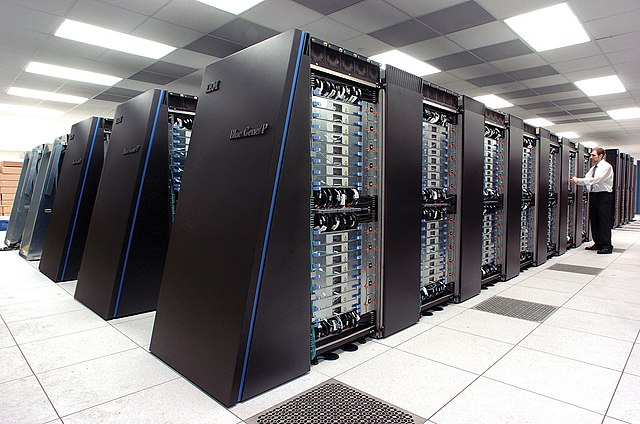In this article, we will learn
1. What are Supercomputers
2. How Supercomputers Work
3. Applications of Supercomputers
5. The World and its Supercomputers
WHAT ARE SUPERCOMPUTERS?
Supercomputers are a special class of computers that yield a very high level of performance as compared to the generic computers that we generally use at our homes and offices. A supercomputer is equipped with a heavy number of processors (usually tens of thousands), and are capable of performing billions and trillions of operations or computations or calculations in a second. Processes that require real time applications are handled with the help of supercomputers.
HOW SUPERCOMPUTERS WORK?
Generic computers most often use serial processing in order to complete operations, i.e., they perform one task at a time. Think of it as a person standing at the entry of a club, who allows only one person in at a time. But supercomputers work differently; they’re built heavier. They process multiple tasks in a parallel processing paradigm, i.e., at the same time just like checking out the entire cart at once while shopping at an e-commerce website.
Since supercomputers are equipped with thousands of processors, their processing power gets amplified hugely which is known as massive parallel processing. To compliment the massive parallel processing, supercomputers use the technology of pipelining as well. In pipelining, the same kinds of information are paired together. Now, when the first pair of information completes its initial phase and moves onto the next step, the second pair of information is pushed into the initial phase of processing and the process continues for the further pairs and thus that’s how supercomputers are able to process a heavy amount of information in a very short span of time. Along with that, supercomputers are also equipped with transistor technology that reduces the ‘transistor switching time’. A transistor’s opening and closing time defines the speed of movement of data in a supercomputer and the faster the transistor opens or closes, the faster the data travels.
In every other aspect of designing, supercomputers are similar to the generic computers we use at homes and offices. They are equipped with a Central Processing Unit (CPU) and a memory unit, where all the instructions are carried out and all the data is stored. The only difference is that the CPU is equipped with high performance circuits and multiple thousand processors to make it fast. While generic computers’ speed is measured in Million Instructions Per Second (MIPS), the speed of a super computer is measured in terms of Floating-Point Operation Per Second (FLOPS).
Japan’s Fukagu is the fastest supercomputer in the world with a maximum performance level of 442,010 teraflops per second.
APPLICATIONS OF SUPERCOMPUTERS
The first ever supercomputer was the CDC-6600, developed at the CERN Computer Centre and released in the year 1962. It was the first ever multi-programmed machine at CERN and was used for analyzing millions of photographs of the experiments conducted at and by CERN throughout the year.

The revolution in the history of supercomputing came in the year 1972 when Seymour Cray developed the Cray-1, which is considered by the experts as the most successful supercomputer till date. The Cray-1 was used for weather forecasting and aerodynamic research. As decades grew so did the uses for supercomputers. In the 1980s, the CDC Cyber mainframe-class supercomputers were used for probabilistic analysis and radiation shielding modeling. The 1990s saw the rise of the EFF DES cracker which was used for brute force code breaking.
Supercomputers are not used for generic tasks such as webpage hosting or creating a spreadsheet or making presentations. They are used for complex processes that are not for the general computers to handle. As of now, supercomputers are used in oil and gas exploration, converting seismic data into maps that indicate where to drill oil and/or gas wells, for heavy ciphering and calculus operations, and also in the fields of quantum mechanics, weather forecasting, climate research, molecular modelling, biological macromolecules, cryptanalysis, and in the simulations of aircrafts, spacecrafts and other heavy machineries.
In the United States, The National Oceanic and Atmospheric Administration use supercomputers for a much more crisp and accurate weather forecasting whereas the nuclear stockpile is also managed and stimulated by The Advanced Simulation and Computing Program using supercomputers only. From the understanding of the universe to the development of heavy-duty spacecrafts, supercomputers are used largely everywhere.
SUPERCOMPUTERS IN INDIA
In the race for technological advancements and supercomputing, India does not fall too far behind. India got its first computer in the year 1991 which was called as the PARAM 8000 and it was capable of carrying out one billion calculations per second. The PARAM series was reportedly used in the designing process of the nuclear weapons tested in May 1998. All these computers were designed under the Centre for Development of Advance Computing (C-DAC) founded in March 1988 under the Department of Electronics (now referred to as the Department of Information Technology)
The National Super Computing Mission (NSM) launched in the year 2015 is making sure that advance computing in India touches new high through research and experimentation. The NSM has managed to invest in startups like oil exploration, flood prediction, aerodynamics and drug discovery. The NSM started the initiative of indigenous assembly of supercomputers within the country. So far, the NSM has been able to assemble Param Shivay, the first of its kind, which was installed at IIT (BHU). Two other sets, namely Param Shakti and Param Brahma were installed at IIT Kharagpur and IISER Pune respectively. India created history in November 2020 when its supercomputer PARAM-Siddhi AI made it into the top 100 of the Top500 list. PARAM-Siddhi AI currently ranks 63 in the list of most powerful supercomputers. Pratyush, another one of India’s supercomputers which is used for weather forecasting ranks 78th in the world. India’s NSM mission not only aims at the assembling of heavy-duty supercomputer, but it also aims to train personnel in such a manner that they could create much better supercomputers to serve the nation in the future.
THE WORLD AND IT’S SUPERCOMPUTERS
Not every country is blessed enough to have a supercomputer of its own. Supercomputers are pretty costly to build and even costlier to maintain. Out of the 195 recognized countries in the world, only 30 have working supercomputers at the moment. Here’s a list of the countries with the number of supercomputers they have:
- China 214
- United States 113
- Japan 34
- France 18
- Germany 17
- Netherlands 15
- Ireland 14
- United Kingdom 12
- Canada 12
- Italy 6
- Saudi Arabia 5
- Brazil 4
- Singapore 4
- South Korea 3
- Taiwan 3
- Switzerland 3
- India 3
- Norway 3
- Finland 2
- UAE 2
- Russia 2
- Poland 2
- Australia 2
- Sweden 2
- Spain 1
- Czechia 1
- Morocco 1
- Austria 1
- Hong Kong 1
- Viet Nam 1
Get stories like this one in your inbox: Sign up for our email and Subscribe Now To Get The Most Anticipated Edition Of Starry Stories Magazine For Free.
READ MORE ARTICLES ON TECHNOLOGY
2. Driverless Trains & IOT (Internet Of Things)
3. The First Computer Game: Spacewar
Photos, Vector Graphics & Illustrations Credits
By Argonne National Laboratory 's Flickr page – originally posted to Flickr as Blue Gene / PFrom Argonne National LaboratoryUploaded using F2ComButton, CC BY-SA 2.0, https://commons.wikimedia.org/w/index.php?curid=6412306
By Jitze Couperus – Flickr: Supercomputer – The Beginnings, CC BY 2.0, https://commons.wikimedia.org/w/index.php?curid=19382150
About Author
Aayush Pathak is pursuing B.A. in Journalism. His interests include writing short stories and poems, watching cricket, gaming and sitcoms. Currently he’s involved in researching about latest trends in technology.
Read all Articles by Aayush Pathak

